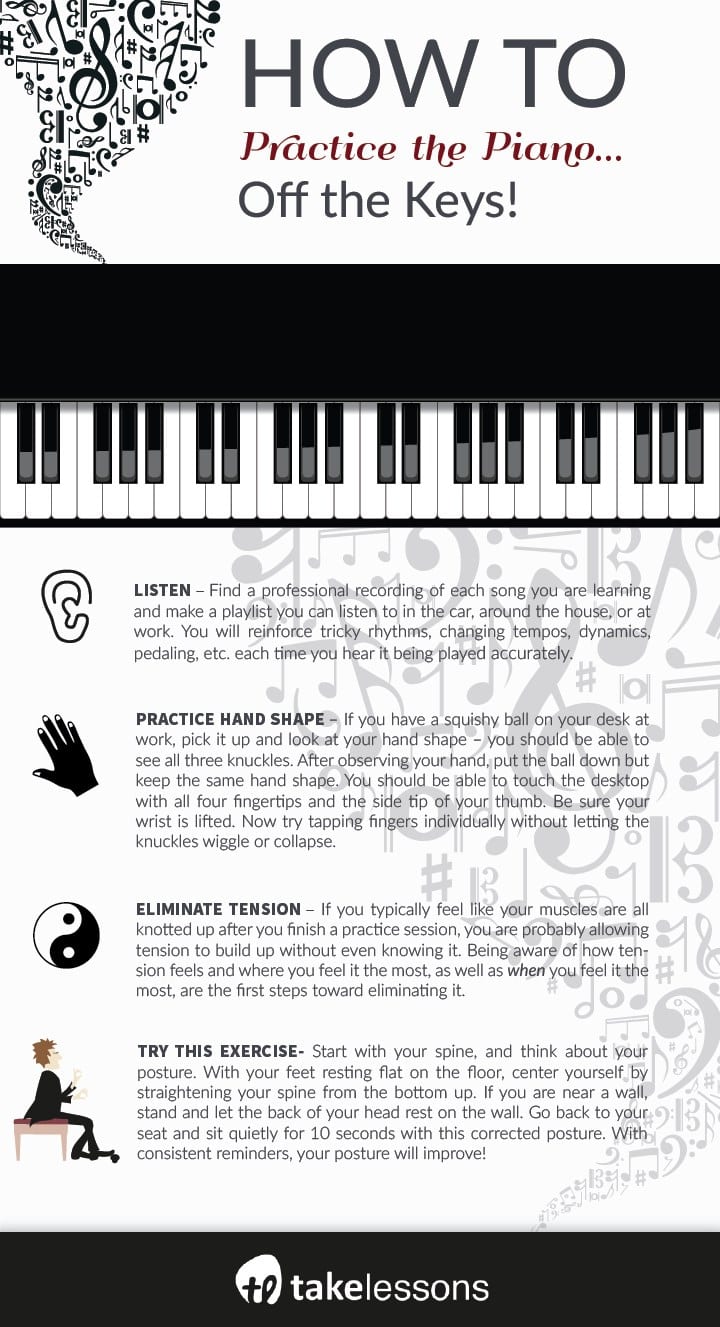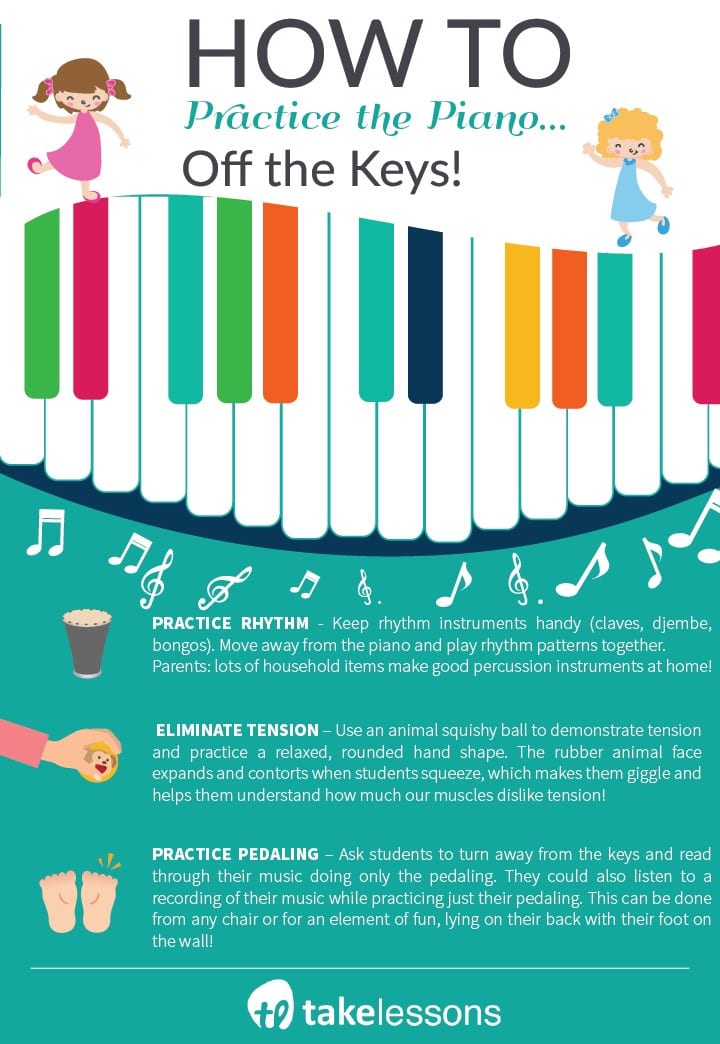We all know how important practicing is for aspiring piano players! But sometimes it can be a challenge to fit into your schedule. Luckily, there are ways to practice your technique while you’re at work, in the car, or practically anywhere else! Continue reading this guest post by Spring Lake, MI piano teacher Val L. to find out how…
As you practice piano, taking the time to think about rhythm and technique is a huge challenge! You should always include scales and exercises in your piano practice routine because they are the tools that will provide the muscle development and coordination needed to improve.
But what should you do if you’re pressed for time? If you have a tight schedule, you’ll want to use every precious minute you have at the piano to work on your songs. Fortunately, there are also ways you can practice your piano technique… even when you’re not in front of your instrument!
Do Piano Exercises Work?
Taking up piano exercises to improve your skills is an incredibly smart decision for anyone, especially for those who are long-time pianists looking to hone their craft:
- That’s because piano exercises can provide long-term benefits, both individually and professionally.
- They increase finger strength, which helps keep long-term playing abilities strong so you can continue to play long into life with little fatigue.
- Also, they help players gains speed, dexterity, and accuracy while playing — all so important considerations when performance counts.
For long-term players looking to stay sharp with their instrument over the years, piano exercises are a must that guarantee long lasting success.
Ready to start learning more about helpful piano finger exercises you can do while on the piano – but also off piano? Ask your piano teacher for tips, and learn more about the benefits of piano lessons below:
https://www.youtube.com/watch?v=ah-fdExgBrY
What Should a Pianist Practice Every Day?
The piano is an amazing instrument, capable of producing beautiful and emotive music with just a few simple strokes. But it takes practice to be able to play the piano well — lots and lots of practice!
If you’re looking for ways to make your daily practice a little more effective, here are four exercises that will help you hone your skills.
Simple Piano Exercises for Tempo and Rhythym
One of the most important aspects of playing the piano is being able to keep time. Practicing tempo and rhythm exercises can help you improve your ability to stay on beat while playing.
Start by clapping out a simple rhythm off the piano and then try playing it on the piano — if you find it difficult, break it down into smaller sections and practice them separately until you can play them together without any hitches.
Piano Scale Exercises
Playing scales is one of the best ways to improve your overall technique on the piano. Start with something simple, like a C major scale, and work your way up from there. As you become more comfortable with scales, try adding different rhythms and tempos — this will help you become even better at playing in time.
Finger Exercises for Piano
Another key component of becoming a good pianist is having strong fingers that can move quickly over the keys. Finger exercises are great for developing speed as well as dexterity; start by working on simple two-finger patterns (such as 1-2-3-4) then move onto more complex patterns (such as 2-1-3-4). Once you’ve mastered those basics, try combining multiple patterns into one exercise for an extra challenge!
Piano Sight Reading Exercises
Sight reading is an essential skill for any pianist — being able to read music quickly will help you learn songs faster, not to mention make sight reading easier during performances or auditions. To get started with sight reading exercises, look up some beginner songs online or take some lessons from a professional teacher — they can provide guidance and feedback so that you can improve your skills in no time!
Off the Keys Piano Exercises for Beginners
For those beginning the journey of learning to play the piano, off the keys exercises are an excellent way to begin. Here are some helpful ways to start!
Simple Piano Exercises for Listening
This one is obvious but easily overlooked. Find a professional recording of each piano song you are learning and make a playlist you can listen to in the car, around the house, or at work. You will reinforce tricky rhythms, changing tempos, dynamics, pedaling, and so on each time you hear it played accurately.
Hand Shape Piano Exercises
You should already know the importance of playing with a rounded hand shape, free from tension. If you have a squishy ball on your desk at work, pick it up right now and look at your hand shape. You should be able to see all three knuckles. Each knuckle has an important part to play in good hand shape, but the knuckle closest to your fingernail is the most important. As a rule, that knuckle should never wiggle or collapse.
Here are some ways to reinforce hand shape while away from the keys:
- After observing your hand shape while holding the ball, put the ball down but keep the same hand shape. You should be able to touch the desktop with all four fingertips and the side tip of your thumb. Be sure your wrist is lifted.
- With that good hand shape, leave your fingers touching the desk and use a little pressure to push into the desk. Release without lifting away from the desk and push in again without letting any of the knuckles wiggle or collapse. Do this without allowing tension to build up in your hands by allowing the pressure to transfer to the fingertips.
- Now try tapping fingers individually without letting the knuckles wiggle or collapse.
- For a greater challenge, widen your span so that the thumb and pinky are fully extended, as if playing an octave. Slide the three long fingers toward your palm until only the flat ends of the fingers are touching the desk. Tap those three long fingers on the desk without letting the knuckle wiggle or collapse, together and individually.
Eliminate Tension Finger Exercises for Piano
If you typically feel like your muscles are all knotted up after you finish a practice session, you are probably allowing tension to build up without even knowing it. Being aware of how tension feels and where you feel it, as well as when you feel it the most, are the first steps toward eliminating it. Wherever you are right now, take a moment to evaluate the tension in your own body.
- Spine – Start here and think about your posture. Are you hunched over or leaning to one side? With your feet resting flat on the floor, center yourself by straightening your spine from the bottom up. If you are near a wall, stand and let the back of your head rest on the wall. This will establish the feeling of good posture. Go back to your seat and sit quietly for 10 seconds with this corrected posture. With consistent reminders, your posture will improve!
Beginner Piano Exercises Off the Keys – Recap
When you do return to the keys, incorporate these important piano practice tips into your routine. Eventually your body will form natural, healthy habits that will greatly enhance your musicianship! (See also: The Healthy (& Happy) Pianist: A Guide to Stress & Injury Prevention)
Here’s a visual to recap these tips…
Off the Keys — Piano Practice Tips for Kids
Kids can be even more resistant to piano technique exercises — but the more fun the exercises are, the better kids typically respond! Here are some of my methods…
Rhythm Piano Exercises
Keep rhythm instruments handy (claves, djembe, bongos) and try to change it up from week to week. Move away from the piano and sit at the table, couch, or even outside, and play rhythm patterns together.
Parents can be involved with rhythm practice at home. Lots of household items make good percussion instruments. Try taking two plastic bottle caps with some “Sticky Tack” inside. Little fingers can develop fine motor skills by tapping the bottle caps together. Buy a set of rhythm flashcards and tap two to three rhythm patterns each day. Or let them create their own rhythm pattern, record it, and then try writing it. At their next lesson, their piano teacher can listen and give feedback on how accurately they wrote the rhythm.
Eliminate Tension Piano Exercises
Young students will understand the meaning of tension by using a squish ball/animal. Kids can use them to practice a relaxed, rounded hand shape. The rubber animal face expands and contorts when they squeeze, which makes them giggle and helps them understand how much our muscles dislike tension! When they relax, the animal face returns to normal and the student remembers the feeling of the relaxed hand shape versus the tense hand shape.
Additionally, here are some ways for children to become aware of tension in other areas of their body:
- Spine – Student should stand near a wall, letting the back of their head rest on the wall. This will establish the feeling of good posture. Have them return to the bench, facing away from the keys and sit quietly for 10 seconds with this corrected posture. Be sure their feet are resting flat on the floor or on a stool of proper height. It helps to show them 10 seconds on a timer before they begin so they know how short this resting time will be!
- Shoulders – Student should breathe in deeply and exhale. Did their shoulders drop? Do they feel more relaxed now? Have them pretend their tummy is a balloon and after they inflate the balloon, they let out all of the air. It’s fun to actually blow up a balloon while they breathe in and let it deflate when they exhale. But some children will be more distracted by the balloon and may not focus on the breathing exercise. If time is available, demonstrate with the balloon first and then put it away.
- Elbows – Student should lay their fingertips on the closed lid of the piano or a table of about the same height and check to see if their elbows are suspended away from their body or if they are lowered and relaxed at their side. Many students love to imagine a monkey swinging on their elbow. Let the monkey swing two or three times and come to a resting position.
- Wrists – Students often struggle with the concept of bending their wrists, but this should be developed during the early years of learning piano. Try having your students use their three long fingers to “paint” a group of three black keys. (They may even want to choose a color.) Have them “paint” those three keys with a smooth, slow stroke – curling the fingers as they slide from the back to the front of the keys. Encourage them to lift their wrists up and down with a beautiful fluid motion. Demonstrate first!
Simple Piano Exercises – the “Zombie”
You can also try this fun “zombie” exercise…
Have students face away from the keys and do a “zombie pose” (arms straight out in front, hands dangling from wrists).
Do a “zombie wave” (flop hands up and down).
Now have them lower their arms and bend at the elbows, continuing to do the “zombie wave.”
Next, have them drop their hands like dead weight, and then let their wrists lift their arms back up while hands continue to dangle.
Have students focus on their wrists at all times. It’s important that they don’t get so caught up in the zombie fun that they miss the point of the exercise!
Pedaling Piano Exercises
Student should turn away from the keys and read through their music doing only the pedaling. They could also listen to a recording of their music while practicing just their pedaling. This can be done from any chair — or for an element of fun, lying on their back with their foot on the wall! Beginners can simply practice keeping their heel on the floor while lifting their toes up and down. Isolating and practicing these simple movements is the first step toward developing their musicianship!
To recap…
What is the Best Piano Exercise for Beginners?
Whether it’s for learning a new skill, honing existing ones, or just for the enjoyment of it, playing the piano is an incredible activity. While most people think of exercises as grueling and tedious processes, when done right they can actually be quite enjoyable. For beginners, scales are one of the best exercises to start with, but please don’t stop there!
Practicing piano doesn’t always mean sitting in front of the instrument – there are plenty of exercises off the keys that can help build skills too! Air piano helps with hand positioning and muscle memory; mental rehearsal is great for visualization; and listening & analyzing tunes helps hone musical ear training & knowledge.
So if you’re feeling stuck in a rut with practicing piano – give one (or all) of these non-keyboard exercises a try! And ask your piano teacher for tips if you’re still not sure how to start.
Your fingers (and ears) will thank you later!
 Post Author: Val L.
Post Author: Val L.Val L. teaches piano lessons in Spring Lake, MI. She earned her Associate of Arts degree from William Tyndale College and has been teaching piano for over 10 years. Learn more about Val here!
Photo by rhodesj
Suzy S.
![How to Practice Piano: Tips for Exercises OFF the Keys! [Infographic]](/_next/image?url=https%3A%2F%2Ftakelessons.com%2Fblog%2Fwp-content%2Fuploads%2F2023%2F04%2FGetty_Image_477703459__1682105645_96134__1682105796_10458.jpg&w=3840&q=75)


